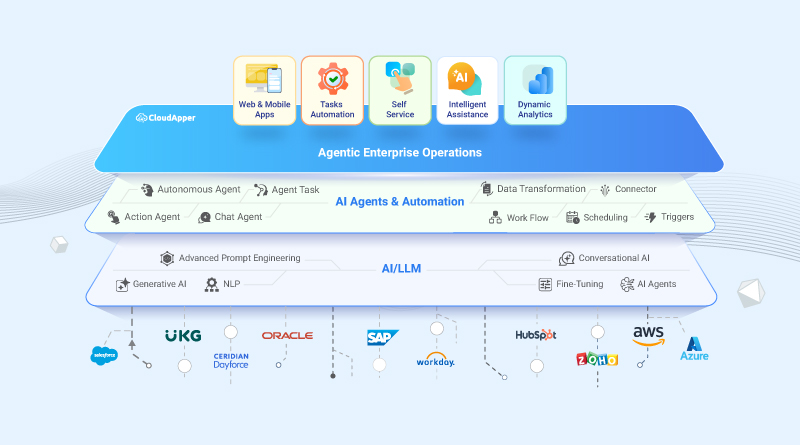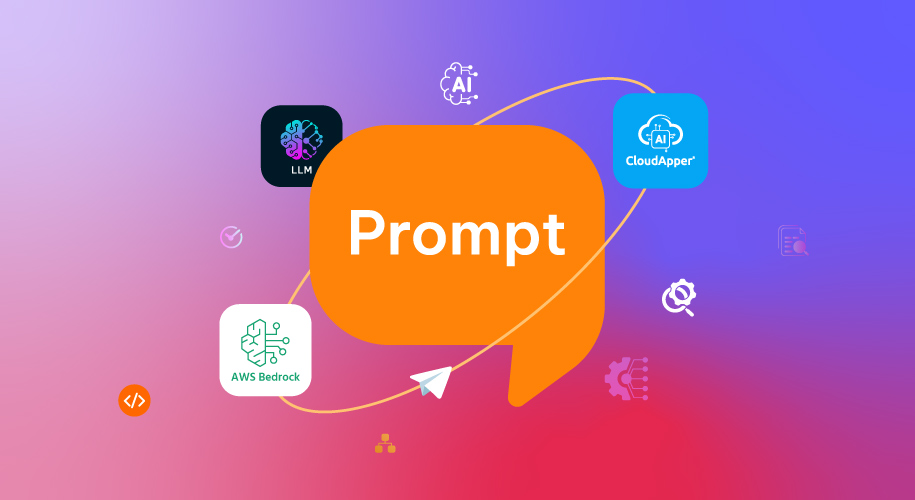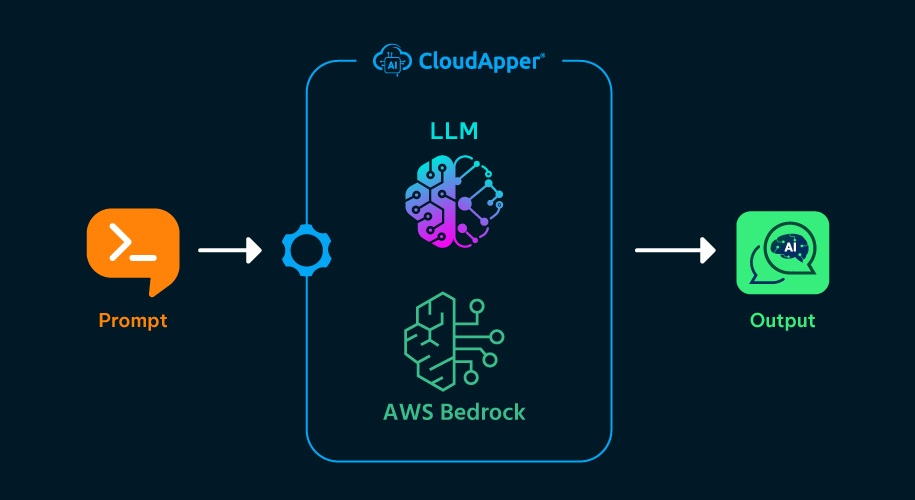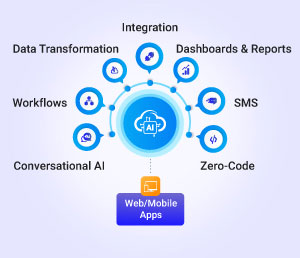CloudApper AI simplifies advanced prompt engineering for Amazon Bedrock, enabling product managers to create, optimize, and deploy AI applications without technical expertise, saving time, reducing costs, and driving innovation.
Table of Contents
Are you a product manager looking to harness the power of generative AI without the headache of complex development processes? In the rapidly changing world of AI, the ability to create effective prompts is crucial for producing high-quality results. While Amazon Bedrock provides a powerful platform for building and deploying generative AI applications, it often requires deep technical knowledge, iterative testing, and a significant time investment. This is where CloudApper AI comes into play, offering a game-changing solution with a simplified, non-technical approach to advanced prompt engineering that saves time, reduces costs, and eliminates the need for specialized development expertise.
Advanced Prompt Engineering with Amazon Bedrock: A Complex Process
For product managers looking to deploy generative AI applications effectively, Amazon Bedrock offers a robust platform with various foundational models, such as Amazon Titan, Claude, and Jurassic-2, which are designed to handle diverse tasks like content generation, summarization, and question-answering. However, leveraging these models to their full potential requires a thorough understanding of advanced prompt engineering techniques — a process that involves significant technical complexity and iterative development.
To begin, advanced prompt engineering with Amazon Bedrock starts with defining precise objectives for your AI application. This involves clarifying the specific tasks the AI needs to perform, understanding the target audience, and identifying the context in which the model will operate. For instance, Amazon Bedrock supports models like Amazon Titan, which excels in generating high-quality, context-aware text and responses. To use Titan effectively, prompts must be tailored to capitalize on its capabilities, such as providing structured instructions that guide the model toward generating the desired output.
One of the key techniques for effective prompt engineering is few-shot learning, where a small number of examples are provided within the prompt to help the model understand the expected format and content of its response. For instance, when using the Jurassic-2 model on Amazon Bedrock, a few-shot prompting can guide the model’s output more accurately by showing examples that frame the context, tone, or style. Another technique is prompt chaining, where outputs from one prompt are fed as inputs into subsequent prompts, breaking down complex tasks into manageable steps that align more closely with the model’s strengths.
However, developing these prompts is not a one-time task. It requires iterative refinement to achieve optimal results. Developers need to use a feedback loop to test, adjust, and re-test prompts based on performance metrics such as output relevance, coherence, and latency. Amazon Bedrock provides tools like real-time model evaluation and automatic tuning to assist in this iterative process, enabling developers to fine-tune their prompts by analyzing model outputs against a range of parameters, such as temperature settings (which control randomness) and max tokens (which control the length of output).
Once the prompts are optimized, the deployment phase involves integrating them with production environments. This step includes managing API calls to Amazon Bedrock, optimizing data throughput, and ensuring low-latency responses for real-time applications. Additionally, handling model versioning, monitoring model performance, and ensuring compliance with data governance policies such as GDPR and CCPA are crucial tasks. This requires a robust DevOps strategy for continuous integration and deployment (CI/CD) and real-time monitoring to detect and respond to performance issues promptly.
While Amazon Bedrock provides a powerful platform and the necessary tools for implementing these techniques, the process is inherently complex and requires a deep understanding of machine learning principles, prompt optimization strategies, and infrastructure management. This is where CloudApper AI can simplify the AWS Bedrock app development process dramatically. With a graphical user interface (GUI) interface and automated prompt generation capabilities, CloudApper AI abstracts away the complexities of advanced prompt engineering, allowing product managers to focus on deploying effective AI solutions without the need for specialized technical expertise. CloudApper AI integrates directly with Amazon Bedrock, handling API management, security protocols, and ongoing model optimization automatically, ensuring that your AI applications are always performing at their best with minimal manual intervention.
How CloudApper AI Simplifies the Process
CloudApper AI makes advanced prompt engineering accessible and straightforward through its visual Workflow builder. Here’s how it works:
Smart Workflow Design
With CloudApper, you can easily build intelligent workflows that adapt based on the context. For example, imagine you’re building a customer support bot. The bot can automatically decide whether to escalate an issue to a live agent or retrieve an answer from a knowledge base, based on the customer’s input. This agent-driven approach allows the workflow to dynamically choose the right action or tool without requiring manual intervention.
Multi-turn Prompts in the Flow
Handling complex conversations is easy with multi-turn prompts. Suppose you’re designing a workflow to handle multi-step processes like booking an appointment. CloudApper’s builder enables the bot to ask follow-up questions, confirm details, and complete tasks—all in a smooth, conversational flow.
Real-Time Iterative Refinement
Refining prompts is also effortless. Let’s say you want to improve how your bot responds to certain queries. With CloudApper, you can tweak prompts, test them live, and instantly see the results. No more waiting for updates to be deployed—just adjust and go!
Seamless Data Integration
Need to pull information from various sources? With CloudApper, you can search through your own documents, retrieve data from your main data store, or even trigger another workflow. For instance, if a user requests their account balance, the bot can fetch the data from the company’s database and display it instantly, or execute another process like sending the balance via email.
No Expertise Required
The best part? You don’t need to be a prompt engineering expert. Product managers, with no deep technical background, can easily build powerful GenAI applications. The platform handles the complexity of prompts behind the scenes, so you can focus on delivering value to users.
Example Use Case
Imagine you’re developing a virtual assistant to help employees navigate company policies. You can create a workflow where the assistant asks a series of questions (multi-turn prompts) to understand what the employee is looking for. It can then search the employee handbook or trigger a query to retrieve specific information, like leave policies or compliance guidelines, without any need for advanced prompt knowledge.
By simplifying the technical hurdles, CloudApper empowers businesses to create efficient, user-friendly AI applications while saving time and effort.
Realizing the Benefits of CloudApper AI
By simplifying advanced prompt engineering, CloudApper AI enables organizations to focus on what matters most — leveraging AI to drive business growth and innovation. The platform offers several key benefits, including accessibility, as it allows anyone in the organization to create and manage AI prompts regardless of their technical background. It enhances efficiency by providing automated tools and user-friendly interfaces that streamline the entire process, from prompt creation to deployment. Additionally, CloudApper AI is cost-effective, reducing development expenses by eliminating the need for specialized AI expertise and minimizing the time required to achieve optimal results. The platform also facilitates rapid deployment, enabling faster market entry for AI applications through simplified prompt engineering and seamless integration with AWS Bedrock. Furthermore, CloudApper AI supports continuous improvement by offering ongoing refinement and optimization, ensuring AI applications remain effective and up-to-date.
Conclusion
Advanced prompt engineering is crucial for tapping into the full potential of generative AI applications, but it doesn’t have to be a daunting task for product managers. With CloudApper AI, you can bypass the technical hurdles often associated with Amazon Bedrock’s traditional development methods. The platform’s intuitive graphical user interface (GUI) and automated tools make it simple for any team member — regardless of their technical background — to create, optimize, and deploy AI prompts. This streamlined approach not only saves time and reduces costs but also accelerates innovation, enabling you to bring AI-driven solutions to market faster.
By leveraging CloudApper AI, you can harness the power of generative AI without the typical complexities, allowing your team to focus on delivering value, driving growth, and achieving strategic goals more efficiently than ever before. It’s about empowering you to lead AI initiatives with confidence and agility, all while keeping your team productive and aligned with your business objectives.
What is CloudApper AI Platform?
CloudApper AI is an advanced platform that enables organizations to integrate AI into their existing enterprise systems effortlessly, without the need for technical expertise, costly development, or upgrading the underlying infrastructure. By transforming legacy systems into AI-capable solutions, CloudApper allows companies to harness the power of Generative AI quickly and efficiently. This approach has been successfully implemented with leading systems like UKG, Workday, Oracle, Paradox, Amazon AWS Bedrock and can be applied across various industries, helping businesses enhance productivity, automate processes, and gain deeper insights without the usual complexities. With CloudApper AI, you can start experiencing the transformative benefits of AI today. Learn More

Brochure
CloudApper hrPad
Empower Frontline Employees with an AI-Powered Tablet/iPad Solution
Download Brochure
CloudApper AI Solutions



- Works with
- and more.
Similar Posts

How Agentic AI Can Help Healthcare Providers Deliver Personalized Patient…

Beyond Developers: How AI Agents Drive Profitability Across the Enterprise




















